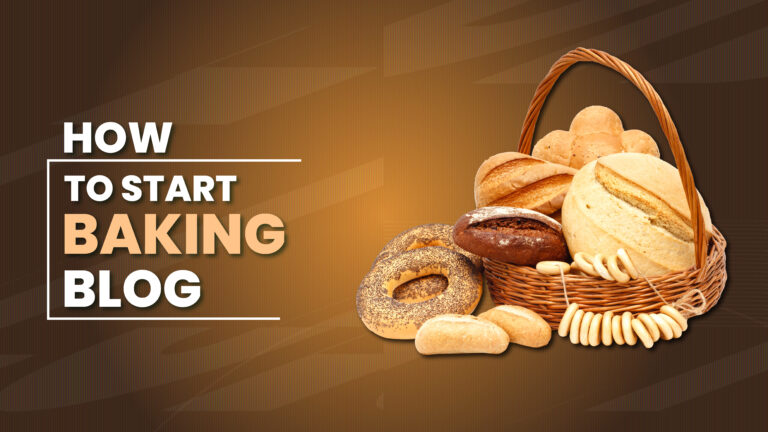Starting a baking blog is an opportunity to share your passion for baking with a wider audience. It provides a platform to teach baking techniques, share recipes, and inspire others in the kitchen. Creating a successful baking blog requires clear goals, a structured approach, and a focus on building a loyal following. This article will guide you through the steps necessary to launch a baking blog and ensure it stands out.
How to Start a Baking Blog in 2025 (Easy Steps)
1. Choose a Niche
Choosing a niche is crucial for a baking blog. While general baking blogs can work, having a unique focus helps you stand out in the crowded blogging world. Examples of niches include:
- Vegan baking
- Gluten-free recipes
- Cake decorating
- Pastry making
- Beginner-friendly baking guides
Choosing a specific niche allows you to target a particular audience, making it easier to build a dedicated community. According to blog experts, niche blogs often perform better because they cater to a specific interest group, which helps drive targeted traffic to your blog.
2. Pick a Memorable Blog Name
Your blog’s name is the first impression potential readers will have. It should reflect your niche and be easy to remember. Ensure the name isn’t too long, difficult to spell, or too similar to other blogs. Many successful baking blogs have names that are playful, descriptive, or related to the blogger’s unique angle. For example:
- The Vegan Cake Chronicles
- Gluten-Free Sweets Haven
- Pastry Perfectionist
Before settling on a name, check if the domain is available. Most website hosting platforms, such as Bluehost or GoDaddy, offer domain name searches.
3. Select a Blogging Platform and Hosting Provider
To start your baking blog, you will need a blogging platform and a web hosting service. WordPress.org is the most popular platform for bloggers due to its flexibility, customization options, and scalability. Other platforms, such as Wix and Squarespace, offer more beginner-friendly interfaces but may have limited features as your blog grows.
Once you choose a platform, you’ll need web hosting to make your blog accessible online. Bluehost, SiteGround, and DreamHost are popular web hosting providers that work well with WordPress. These hosting services offer affordable plans, fast loading speeds, and reliable uptime.
4. Design a Visually Appealing Website
Visual appeal is essential for a baking blog because food blogging relies heavily on aesthetics. A clean, easy-to-navigate website design ensures a positive user experience. Start by choosing a theme that aligns with your niche. For example, if you’re focusing on dessert recipes, you may want a theme with bright, warm colors and plenty of space for high-quality images.
Many WordPress themes are designed specifically for food blogs and offer built-in recipe plugins and features like ingredient lists, cooking instructions, and nutritional information sections. Popular themes for food bloggers include Foodie Pro, Cook’d Pro, and Kale.
5. Create Quality Content
Quality content is the foundation of a successful baking blog. Your readers will come to your blog for recipes, tips, and baking inspiration, so it’s important to offer content that is both informative and engaging. Key types of content for a baking blog include:
- Recipes: Include step-by-step instructions, ingredient lists, and high-quality images. Many food bloggers recommend providing detailed explanations for baking techniques.
- Baking Tips: Share valuable tips and tricks, such as how to troubleshoot common baking problems or how to achieve the perfect cake texture.
- Tutorials: Offer tutorials on specific techniques, such as making buttercream flowers, kneading dough, or tempering chocolate.
- Behind-the-Scenes Content: Showcase the process of developing recipes or share personal stories about your baking journey.
To enhance content quality, ensure that each post is well-organized and includes relevant keywords to improve SEO. Using tools like Yoast SEO can help you optimize your posts for search engines.
6. Invest in Photography
Food photography plays a critical role in the success of a baking blog. High-quality images are more likely to be shared on social media and draw attention to your blog. Many successful food bloggers recommend investing in a DSLR camera or high-end smartphone camera to capture professional-looking photos.
Key tips for photographing baked goods include:
- Lighting: Use natural lighting whenever possible to create bright and appetizing images.
- Angles: Experiment with different angles to highlight the texture and color of your baked goods.
- Props and Styling: Simple, clean props can help frame your food without distracting from it. Choose plates, napkins, and backgrounds that complement your dish.
7. Implement SEO Strategies
Search engine optimization (SEO) is critical for increasing the visibility of your blog. Optimizing your blog posts for SEO helps them rank higher in search engine results, making it easier for new readers to discover your content. SEO strategies to focus on include:
- Keyword Research: Use tools like Google Keyword Planner or SEMrush to find relevant keywords for your niche.
- Optimized Titles: Create descriptive, keyword-rich titles that accurately reflect the content of your blog posts.
- Meta Descriptions: Include a brief meta description that summarizes your post and includes relevant keywords.
- Alt Text for Images: Add alt text to all images to improve your blog’s accessibility and SEO performance.
8. Engage with Your Audience
Building a loyal following requires consistent engagement with your readers. Responding to comments, answering questions, and interacting with followers on social media can help create a sense of community around your blog. Some effective ways to engage include:
- Social Media Interaction: Share behind-the-scenes content, new recipes, and baking tips on platforms like Instagram, Facebook, or Pinterest.
- Email Newsletters: Send regular newsletters to your subscribers with exclusive content, such as new recipes or baking tips.
- User-Generated Content: Encourage readers to share their own baking creations based on your recipes. Feature their photos on your blog or social media channels.
9. Monetize Your Blog
Once your baking blog has gained traction, there are several ways to monetize it. The most common methods include:
- Affiliate Marketing: Promote products and baking tools that you use in your recipes. Amazon Associates is a popular affiliate program for food bloggers.
- Sponsored Content: Partner with brands to create sponsored posts, where you review or promote specific products.
- Display Ads: Join ad networks like Google AdSense to place ads on your blog and earn revenue based on impressions or clicks.
10. Promote Your Blog
Promoting your blog is essential to growing your audience. A successful promotion strategy includes:
- Social Media Marketing: Share your blog posts on social media platforms, engage with followers, and participate in relevant baking groups or communities.
- Pinterest: Create visually appealing pins for each recipe and share them on Pinterest. Many food bloggers find Pinterest to be a top source of traffic.
- Collaborations: Partner with other bloggers for guest posts, recipe roundups, or social media takeovers to reach new audiences.
Conclusion
Starting a baking blog requires a combination of passion, creativity, and strategic planning. By focusing on a specific niche, creating high-quality content, and engaging with your audience, you can build a successful blog that attracts readers and keeps them coming back for more. Additionally, investing in photography, SEO, and promotion will help your blog gain visibility and grow over time. As your blog flourishes, there are many opportunities for monetization, from affiliate marketing to sponsored posts. With the right approach, you can turn your love for baking into a thriving online presence.
Also Read
Frequently Asked Questions (FAQs)
How do I choose a niche for my baking blog?
To choose a niche, consider your personal baking strengths and passions. Narrowing your focus to a specific area, like vegan baking or cake decorating, helps you attract a dedicated audience.
Do I need professional photography equipment for my blog?
While professional cameras can improve the quality of your photos, many successful bloggers use high-end smartphones with natural lighting to capture great images.
How long does it take to start seeing traffic on my blog?
Building an audience can take time. It often takes several months of consistent posting, engagement, and SEO efforts to start seeing significant traffic.
Can I monetize my blog right away?
Monetization is usually more successful after building an audience. Once your blog has steady traffic, you can explore affiliate marketing, ads, and sponsored content.
What platforms are best for promoting a baking blog?
Instagram and Pinterest are particularly effective for food bloggers, as they focus on visual content. Joining baking groups on Facebook can also help you connect with readers.

